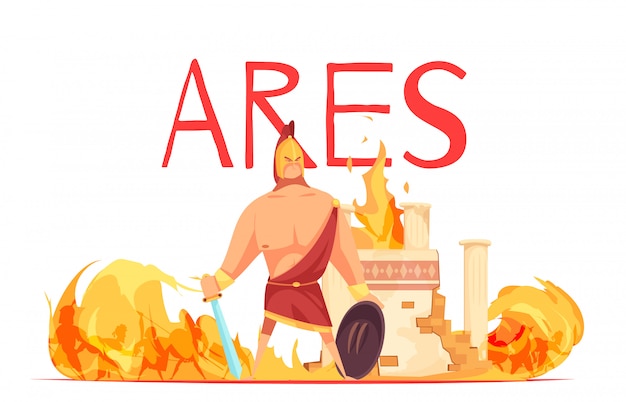Ares Facts – Unveiling the Mythology and Characteristics of the Greek God of War

Ares, the Greek god of war, was known for his fiery and impulsive nature.
Ares was the son of Zeus and Hera, making him a powerful and influential god.
Unlike other gods, Ares was not highly regarded and often seen as a troublesome character.
Ares was accompanied by his sister, Eris, the goddess of strife and discord.
Ares was often represented as a tall and muscular warrior dressed in armor.
Ares was a master of weaponry and was known for his exceptional fighting skills.
Ares was also associated with courage, making him an important deity for warriors.
Despite his warlike nature, Ares was also worshipped as a protector of cities and soldiers.
Ares was often depicted riding a chariot pulled by four fire-breathing horses.
Ares was notorious for his love affairs with the goddess of love, Aphrodite.
Ares and Aphrodite’s clandestine affair was discovered by the sun god, Helios.
Ares’ affair with Aphrodite led to the birth of several children, including Eros, the god of love.
Ares was involved in numerous battles and wars throughout Greek mythology.
Ares was feared by both mortals and gods due to his destructive nature on the battlefield.
Ares played a significant role in the Trojan War, supporting the Trojans against the Greeks.
Ares’ involvement in the Trojan War resulted in his defeat by the Greek hero, Diomedes.
Ares had a sacred bird, the vulture, which was often associated with war and death.
Ares Facts – Unveiling the Mythology and Characteristics of the Greek God of War part 2
Ares was part of a group of gods known as the Twelve Olympians.
Ares had a twin sister, Athena, who was the goddess of wisdom and strategic warfare.
Ares’ blind rage often led him to make impulsive decisions without considering the consequences.
Ares’ children, Phobos and Deimos, were personifications of fear and terror.
Ares was worshipped in various cults throughout ancient Greece.
The Romans identified Ares with their own god of war, Mars.
Ares was frequently depicted in ancient Greek art, showcasing his fierce and aggressive demeanor.
Ares’ sacred animals were the dog and the snake, symbolizing loyalty and danger.
Ares’ Roman counterpart, Mars, became a symbol of military strength and conquest.
Ares was associated with the planet Mars due to its reddish color resembling bloodshed.
Ares’ vengeful nature often brought him into conflict with other gods, such as Zeus and Apollo.
Ares’ temperament often made him an unpredictable and dangerous deity.
Ares was not popular among the other gods and often faced their mockery and ridicule.
Ares’ temples were often located outside the city walls, symbolizing his association with war.
Ares’ sister, Eris, stirred up chaos and discord wherever she went, often accompanying him into battle.
Ares’ battles with other gods often resulted in destruction and devastation.
Ares’ love for violence and conflict made him a patron deity for gladiators and warriors.
Ares’ armor and weaponry were said to be forged by the Cyclops, skilled blacksmiths of Greek mythology.
Ares was said to be fearless in battle, never backing down from a fight.
Ares’ war cries were said to strike fear into the hearts of his enemies.
Ares’ worshippers often engaged in ritualistic warfare and blood sacrifices to honor him.
Ares’ influence extended beyond the Greek world, with his worship spreading to other cultures.
Ares’ helmet was said to grant invincibility to whoever wore it in battle.
Ares’ association with violence and aggression sometimes overshadowed his more positive aspects, such as his bravery and determination.
Ares’ love for warfare often caused conflicts and disputes among both mortals and gods.
Ares’ character reflected the darker side of human nature, the desire for power and conquest.
Ares’ dual nature of both protector and destroyer made him a complex and multifaceted deity.
Ares’ role in Greek mythology showcases the complexities and contradictions of war and its impact on individuals and society.

